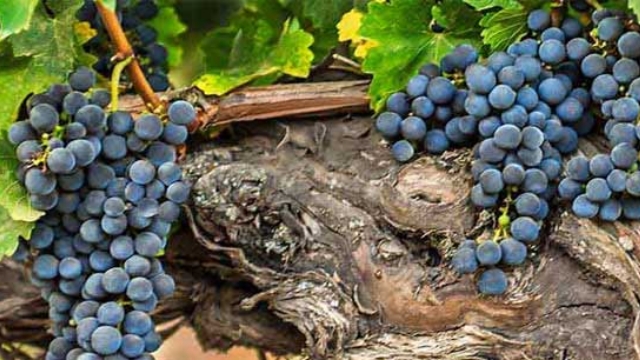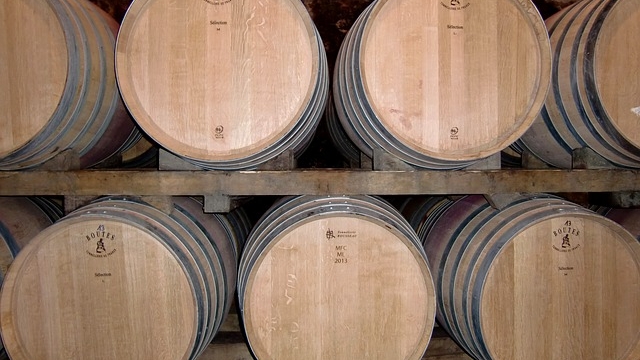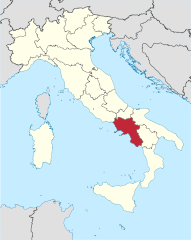That Useful Wine Site
Search, or just roll your cursor over the colored boxes farther below.click the “x” to dismiss Search-results block.




Advertisement:
Advertisement:
Quick page jumps:
(Synonyms: Palombina, Palumbina, Palumbo, Palumina, Per’e Palummo, Streppa Verde.)

Piedirosso is an ancient red-wine grape originating in the Campania region of Italy, at or near Mount Vesuvius; nowadays, it is grown mainly around Naples. This variety is not the same as either Piedirosso Avellinese or Piedirosso Napoletano (neither of which is commercially produced, so you should be safe with any bottling labelled “Piedirosso”). This variety is the dominant (and sometimes sole) grape used in the famous “Lacryma/Lacrima Christi del Vesuvio Rosso” wines (the only other allowed grape being Sciascinoso aka Olivella, a grape rarely seen other than in Lacryma Rossi).
Well-made Piedirosso wines are about as dark a color as red wines can get. They are said to be rich in the usual red-wine flavors and aromas—red fruit and dark fruit—but also to have some dark-flavor overtones such as mushroom, damp earth, and even espresso. And besides all that, they have a perceptible minerality plus what is usually called a hint of salinity. All in all, quite a complex of sensations.
Factoid: Piedirosso means “red feet”, but the reference is to the appearance of the grape bunches, said to resemble the toe of a pigeon or dove (hence its local name Per’e Palummo, meaning leg of the pigeon, or dove if pigeons are too plebian).
This is another fine variety hard to get in the U.S. marketplace (especially like so many fine Italian wines). Between actual “Piedirosso” and “Lacryma Christi Rosso” labels, there are quite a few available, but almost all carried by—per the wine search engines—one or at most two shops; and most of those bottlings have few or no critical reviews available. The short list below is all we could find of decent quality and price with reasonable availability (and even that a bit scant).
• This wine’s Wine Searcher “Reviews” page.
• This wine’s CellarTracker review pages.
• Retail offers of this wine listed by Wine Searcher.
• Retail offers of this wine listed by 1000 Corks.
• This wine’s Wine Searcher “Reviews” page.
• This wine’s CellarTracker review pages.
• Retail offers of this wine listed by Wine Searcher.
• Retail offers of this wine listed by 1000 Corks.
We could find no reasonably available Piedirosso wines better enough than those listed above as to justify a “splurge” price.
Advertisement:
Advertisement:
|
|
This site is one of The Owlcroft Company family of web sites. Please click on the link (or the owl) to see a menu of our other diverse user-friendly, helpful sites. |
|
| (Note: All Owlcroft systems run on Ubuntu Linux and we heartily recommend it to everyone—click on the link for more information). | ||
|
All content copyright © 2024 The Owlcroft Company
(excepting quoted material, which is believed to be Fair Use). |
This web page is strictly compliant with the W3C (World Wide Web Consortium) Extensible HyperText Markup Language (XHTML) Protocol v1.0 (Transitional) and the W3C Cascading Style Sheets (CSS) Protocol v3 — because we care about interoperability. Click on the logos below to test us!
This page was last modified on Saturday, 30 October 2021, at 11:26 pm Pacific Time.
Some Descriptions of Piedirosso Wines
“Single-variety wines made from Piedirosso tend to be deep ruby in color and full bodied with soft tannins. Typical flavors in these wines include plum, cherry and brambly wild berry fruit. More complex characteristics such as espresso, mushroom and damp earth are exhibited in the better examples. A minerally, almost salty characteristic can be found in many Piedirosso wines. This can in part be attributed to the volcanic soils in which the grape thrives…Perhaps the best-known wines majoring on Piedirosso are the Lacryma Christi del Vesuvio red and rosé wines. In these the [Piedirosso] must make up a minimum of 50 percent of the blend.”
“Piedirosso is used to make single-varietal wines as well as blends. The blends are more popular than the varietal wines but, the varietal wines too possess some of the very striking characteristics. Talking about the characteristics of the single varietal wines, the wines are deep ruby in colour. The colour is very striking in its appearance. The wines are very full-bodied and possess soft tannins. The wine also has some striking flavours that are soft, subtle and please the taste buds to the core. The wines show flavours of brambly wild berry fruit, cherry and plum. Some of the other complex characteristics that this wine showcases are simply exhiliriating. They include the characters of mushroom, damp earth and espresso. Many Piedirosso wines show a minerally character, a little salty. This is quite a distinct character which can be due to volcanic soils on which the vines bloom. All the single-variety wines made from Piedirosso are tagged under IGT title.”
“Piedirosso become a modern, fresh, thin wine with a good drinkability. The color is a little red and the smell is characterized by geranium, red flowers and red fruit aromas. It isn’t too much alcoholic. The result is a fresh wine with silky and kind tannins, just perfect to be matched with sea dishes.”
“Piedirosso from Campania should be juicy and floral without giving up texture: tannic enough to demand food, insistently fruity enough to accompany it. In Native Wine Grapes of Italy, [Ian] D’Agata’s notes on the vinification of this storied grape: ‘effusive fruity and floral (can be green), bright red berry, complicated by obvious tar and herbal notes.’”
“ While it was widely produced in the 19th century, it is lesser known today. But like many ancient grapes, it is making a comeback.…Vines are grown in the volcanic soil of Mt. Vesuvius, making for striking flavors that are soft and well-rounded with great complexity. A subtle minerality and almost salty like characteristic can be noticed in many wines, showing strong terroir attributed to the volcanic soils. The finished product shines with notes of plum, cherry and wild bramble berry. Often found as a blending grape to Aglianico to soften its strong tannins, more often we are finding this wine as a single varietal in the market place.”
“[W]hen Piedirosso ripens properly it yields a remarkably satisfying wine characterized by bright red-berry and floral aromas and flavors, complicated by obvious tar and herbal notes and a saline tang. It’s the floral element (geranium, lavender, and with age violet) that sets the good wines apart from the bad ones (which aren’t floral but vegetal). In fact, I find Piedirosso a good candidate for carbonic maceration techniques, for its effusively fruity and floral aromas can be downright charming.”